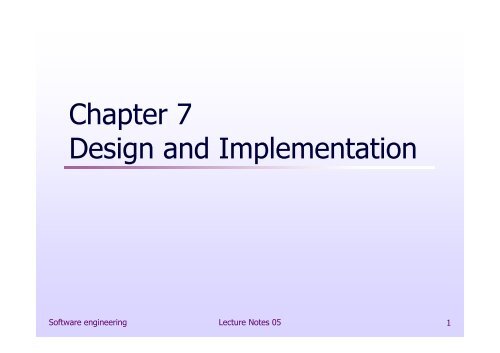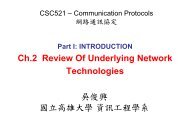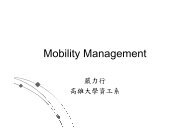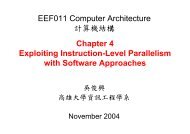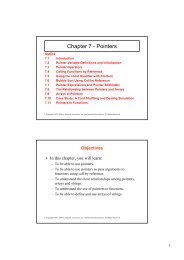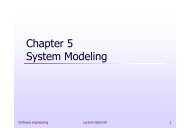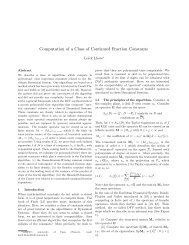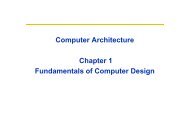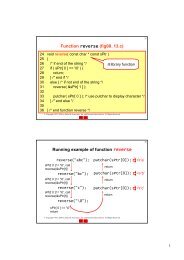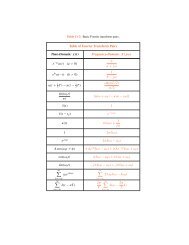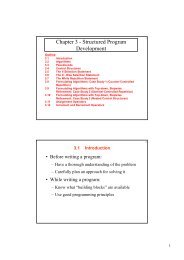Chapter 7 Design and Implementation
Chapter 7 Design and Implementation
Chapter 7 Design and Implementation
You also want an ePaper? Increase the reach of your titles
YUMPU automatically turns print PDFs into web optimized ePapers that Google loves.
Topics covered Object-oriented design using the UML <strong>Design</strong> patterns <strong>Implementation</strong> issues Open source developmentSoftware engineering Lecture Notes 05 2
<strong>Design</strong> <strong>and</strong> implementation Software design <strong>and</strong> implementation is the stage inthe software engineering process at which anexecutable software system is developed. Software design <strong>and</strong> implementation activities areinvariably inter-leaved.Software design is a creative activity in which youidentify software components <strong>and</strong> their relationships,based on a customer’s requirements.<strong>Implementation</strong> is the process of realizing the design asa program.Software engineering Lecture Notes 05 3
Build or buy In a wide range of domains, it is now possible tobuy commercial off-the-shelf systems (COTS) thatcan be adapted <strong>and</strong> tailored to the users’requirements.For example, if you want to implement a medical recordssystem, you can buy a package that is already used inhospitals. It can be cheaper <strong>and</strong> faster to use thisapproach rather than developing a system in aconventional programming language. When you develop an application in this way, thedesign process becomes concerned with how touse the configuration features of that system todeliver the system requirements.Software engineering Lecture Notes 05 4
An object-oriented design process Structured object-oriented design processesinvolve developing a number of differentsystem models. They require a lot of effort for development<strong>and</strong> maintenance of these models <strong>and</strong>, forsmall systems, this may not be cost-effective. However, for large systems developed bydifferent groups design models are animportant communication mechanism.Software engineering Lecture Notes 05 5
Process stages There are a variety of different object-orienteddesign processes that depend on the organizationusing the process. Common activities in these processes include:Define the context <strong>and</strong> modes of use of the system;<strong>Design</strong> the system architecture;Identify the principal system objects;Develop design models;Specify object interfaces. Process illustrated here using a design for awilderness weather station.Software engineering Lecture Notes 05 6
System context <strong>and</strong> interactions Underst<strong>and</strong>ing the relationships between thesoftware that is being designed <strong>and</strong> its externalenvironment is essential for deciding how toprovide the required system functionality <strong>and</strong> howto structure the system to communicate with itsenvironment. Underst<strong>and</strong>ing of the context also lets youestablish the boundaries of the system. Setting thesystem boundaries helps you decide what featuresare implemented in the system being designed <strong>and</strong>what features are in other associated systems.Software engineering Lecture Notes 05 7
Context <strong>and</strong> interaction models A system context model is a structural modelthat demonstrates the other systems in theenvironment of the system being developed. An interaction model is a dynamic modelthat shows how the system interacts with itsenvironment as it is used.Software engineering Lecture Notes 05 8
System context for the weather stationSoftware engineering Lecture Notes 05 9
Weather station use casesSoftware engineering Lecture Notes 05 10
Use case descriptionReport weatherSystemUse caseActorsDescriptionStimulusResponseCommentsWeather stationReport weatherWeather information system, Weather stationThe weather station sends a summary of the weather data that has beencollected from the instruments in the collection period to the weatherinformation system. The data sent are the maximum, minimum, <strong>and</strong>average ground <strong>and</strong> air temperatures; the maximum, minimum, <strong>and</strong>average air pressures; the maximum, minimum, <strong>and</strong> average wind speeds;the total rainfall; <strong>and</strong> the wind direction as sampled at five-minute intervals.The weather information system establishes a satellite communication linkwith the weather station <strong>and</strong> requests transmission of the data.The summarized data is sent to the weather information system.Weather stations are usually asked to report once per hour but thisfrequency may differ from one station to another <strong>and</strong> may be modified inthe future.Software engineering Lecture Notes 05 11
Architectural design Once interactions between the system <strong>and</strong> itsenvironment have been understood, you use thisinformation for designing the system architecture. You identify the major components that make upthe system <strong>and</strong> their interactions, <strong>and</strong> then mayorganize the components using an architecturalpattern such as a layered or client-server model. The weather station is composed of independentsubsystems that communicate by broadcastingmessages on a common infrastructure.Software engineering Lecture Notes 05 12
High-level architecture of theweather stationSoftware engineering Lecture Notes 05 13
Architecture of data collectionsystemSoftware engineering Lecture Notes 05 14
Object class identification Identifying object classes is often a difficultpart of object oriented design. There is no 'magic formula' for objectidentification. It relies on the skill,experience<strong>and</strong> domain knowledge of system designers. Object identification is an iterative process.You are unlikely to get it right first time.Software engineering Lecture Notes 05 15
Approaches to identification Use a grammatical approach based on a naturallanguage description of the system (used in HoodOOD method). Base the identification on tangible things in theapplication domain. Use a behavioural approach <strong>and</strong> identify objectsbased on what participates in what behaviour. Use a scenario-based analysis. The objects,attributes <strong>and</strong> methods in each scenario areidentified.Software engineering Lecture Notes 05 16
Weather station descriptionA weather station is a package of software controlledinstruments which collects data, performs some dataprocessing <strong>and</strong> transmits this data for further processing.The instruments include air <strong>and</strong> ground thermometers,an anemometer, a wind vane, a barometer <strong>and</strong> a raingauge. Data is collected periodically.When a comm<strong>and</strong> is issued to transmit the weatherdata, the weather station processes <strong>and</strong> summarises thecollected data. The summarised data is transmitted tothe mapping computer when a request is received.Software engineering Lecture Notes 05 17
Weather station object classes Object class identification in the weather stationsystem may be based on the tangible hardware<strong>and</strong> data in the system:Ground thermometer, Anemometer, BarometerApplication domain objects that are ‘hardware’ objects related tothe instruments in the system.Weather stationThe basic interface of the weather station to its environment. Ittherefore reflects the interactions identified in the use-casemodel.Weather dataEncapsulates the summarized data from the instruments.Software engineering Lecture Notes 05 18
Weather station object classesSoftware engineering Lecture Notes 05 19
<strong>Design</strong> models <strong>Design</strong> models show the objects <strong>and</strong> objectclasses <strong>and</strong> relationships between theseentities. Static models describe the static structure ofthe system in terms of object classes <strong>and</strong>relationships. Dynamic models describe the dynamicinteractions between objects.Software engineering Lecture Notes 05 20
Examples of design models Subsystem models that show logical groupings ofobjects into coherent subsystems. Sequence models that show the sequence of objectinteractions. State machine models that show how individualobjects change their state in response to events. Other models include use-case models,aggregation models, generalisation models, etc.Software engineering Lecture Notes 05 21
Subsystem models Shows how the design is organised intologically related groups of objects. In the UML, these are shown using packages- an encapsulation construct. This is a logicalmodel. The actual organisation of objects inthe system may be different.Software engineering Lecture Notes 05 22
Sequence models Sequence models show the sequence of objectinteractions that take placeObjects are arranged horizontally across the top;Time is represented vertically so models are read top tobottom;Interactions are represented by labelled arrows,Different styles of arrow represent different types ofinteraction;A thin rectangle in an object lifeline represents the timewhen the object is the controlling object in the system.Software engineering Lecture Notes 05 23
Sequence diagram describingdata collectionSoftware engineering Lecture Notes 05 24
State diagrams State diagrams are used to show how objectsrespond to different service requests <strong>and</strong> the statetransitions triggered by these requests. State diagrams are useful high-level models of asystem or an object’s run-time behavior. You don’t usually need a state diagram for all ofthe objects in the system. Many of the objects in asystem are relatively simple <strong>and</strong> a state modeladds unnecessary detail to the design.Software engineering Lecture Notes 05 25
Weather station state diagramSoftware engineering Lecture Notes 05 26
Interface specification Object interfaces have to be specified so that theobjects <strong>and</strong> other components can be designed inparallel. <strong>Design</strong>ers should avoid designing the interfacerepresentation but should hide this in the objectitself. Objects may have several interfaces which areviewpoints on the methods provided. The UML uses class diagrams for interfacespecification but Java may also be used.Software engineering Lecture Notes 05 27
Weather station interfacesSoftware engineering <strong>Chapter</strong> Lecture 7 <strong>Design</strong> <strong>and</strong> Notes implementation 05 28 28
Key pointsSoftware design <strong>and</strong> implementation are inter-leaved activities. Thelevel of detail in the design depends on the type of system <strong>and</strong> whetheryou are using a plan-driven or agile approach.The process of object-oriented design includes activities to design thesystem architecture, identify objects in the system, describe the designusing different object models <strong>and</strong> document the component interfaces.A range of different models may be produced during an object-orienteddesign process. These include static models (class models,generalization models, association models) <strong>and</strong> dynamic models(sequence models, state machine models).Component interfaces must be defined precisely so that other objectscan use them. A UML interface stereotype may be used to defineinterfaces.Software engineering Lecture Notes 05 29
<strong>Design</strong> patterns A design pattern is a way of reusing abstractknowledge about a problem <strong>and</strong> its solution. A pattern is a description of the problem <strong>and</strong>the essence of its solution. It should be sufficiently abstract to bereused in different settings. Pattern descriptions usually make use ofobject-oriented characteristics such asinheritance <strong>and</strong> polymorphism.Software engineering Lecture Notes 05 30
Pattern elements NameA meaningful pattern identifier. Problem description. Solution description.Not a concrete design but a template for a designsolution that can be instantiated in different ways. ConsequencesThe results <strong>and</strong> trade-offs of applying the pattern.Software engineering Lecture Notes 05 31
The Observer pattern NameObserver. DescriptionSeparates the display of object state from the objectitself. Problem descriptionUsed when multiple displays of state are needed. Solution descriptionSee slide with UML description. ConsequencesOptimisations to enhance display performance areimpractical.Software engineering Lecture Notes 05 32
The Observer pattern (1)Pattern nameObserverDescriptionSeparates the display of the state of an object from the object itself <strong>and</strong>allows alternative displays to be provided. When the object state changes, alldisplays are automatically notified <strong>and</strong> updated to reflect the change.ProblemdescriptionIn many situations, you have to provide multiple displays of state information,such as a graphical display <strong>and</strong> a tabular display. Not all of these may beknown when the information is specified. All alternative presentations shouldsupport interaction <strong>and</strong>, when the state is changed, all displays must beupdated.This pattern may be used in all situations where more than onedisplay format for state information is required <strong>and</strong> where it is not necessaryfor the object that maintains the state information to know about the specificdisplay formats used.Software engineering Lecture Notes 05 33
The Observer pattern (2)Pattern nameSolutiondescriptionObserverThis involves two abstract objects, Subject <strong>and</strong> Observer, <strong>and</strong> two concreteobjects, ConcreteSubject <strong>and</strong> ConcreteObject, which inherit the attributes of therelated abstract objects. The abstract objects include general operations that areapplicable in all situations. The state to be displayed is maintained inConcreteSubject, which inherits operations from Subject allowing it to add <strong>and</strong>remove Observers (each observer corresponds to a display) <strong>and</strong> to issue anotification when the state has changed.The ConcreteObserver maintains a copy of the state of ConcreteSubject <strong>and</strong>implements the Update() interface of Observer that allows these copies to be keptin step. The ConcreteObserver automatically displays the state <strong>and</strong> reflectschanges whenever the state is updated.ConsequencesThe subject only knows the abstract Observer <strong>and</strong> does not know details of theconcrete class. Therefore there is minimal coupling between these objects.Because of this lack of knowledge, optimizations that enhance displayperformance are impractical. Changes to the subject may cause a set of linkedupdates to observers to be generated, some of which may not be necessary.Software engineering Lecture Notes 05 34
Multiple displays using theObserver patternSoftware engineering Lecture Notes 05 35
A UML model of the Observer patternSoftware engineering Lecture Notes 05 36
<strong>Design</strong> problems To use patterns in your design, you need torecognize that any design problem you are facingmay have an associated pattern that can beapplied.Tell several objects that the state of some other objecthas changed (Observer pattern).Tidy up the interfaces to a number of related objectsthat have often been developed incrementally (Façadepattern).Provide a st<strong>and</strong>ard way of accessing the elements in acollection, irrespective of how that collection isimplemented (Iterator pattern).Allow for the possibility of extending the functionality ofan existing class at run-time (Decorator pattern).Software engineering Lecture Notes 05 37
<strong>Implementation</strong> issues Focus here is not on programming, although this isobviously important, but on other implementation issuesthat are often not covered in programming texts:Reuse Most modern software is constructed by reusing existingcomponents or systems. When you are developing software, youshould make as much use as possible of existing code.Configuration management During the development process, youhave to keep track of the many different versions of each softwarecomponent in a configuration management system.Host-target development Production software does not usuallyexecute on the same computer as the software developmentenvironment. Rather, you develop it on one computer (the hostsystem) <strong>and</strong> execute it on a separate computer (the target system).Software engineering Lecture Notes 05 38
Reuse From the 1960s to the 1990s, most new softwarewas developed from scratch, by writing all code ina high-level programming language.The only significant reuse or software was the reuse offunctions <strong>and</strong> objects in programming language libraries. Costs <strong>and</strong> schedule pressure mean that thisapproach became increasingly unviable, especiallyfor commercial <strong>and</strong> Internet-based systems. An approach to development based around thereuse of existing software emerged <strong>and</strong> is nowgenerally used for business <strong>and</strong> scientific software.Software engineering Lecture Notes 05 39
Reuse levels The abstraction levelAt this level, you don’t reuse software directly but useknowledge of successful abstractions in the design ofyour software. The object levelAt this level, you directly reuse objects from a libraryrather than writing the code yourself. The component levelComponents are collections of objects <strong>and</strong> object classesthat you reuse in application systems. The system levelAt this level, you reuse entire application systems.Software engineering Lecture Notes 05 40
Reuse costs The costs of the time spent in looking for software to reuse<strong>and</strong> assessing whether or not it meets your needs. Where applicable, the costs of buying the reusable software.For large off-the-shelf systems, these costs can be veryhigh. The costs of adapting <strong>and</strong> configuring the reusable softwarecomponents or systems to reflect the requirements of thesystem that you are developing. The costs of integrating reusable software elements witheach other (if you are using software from different sources)<strong>and</strong> with the new code that you have developed.Software engineering Lecture Notes 05 41
Configuration management Configuration management is the name given tothe general process of managing a changingsoftware system. The aim of configuration management is to supportthe system integration process so that alldevelopers can access the project code <strong>and</strong>documents in a controlled way, find out whatchanges have been made, <strong>and</strong> compile <strong>and</strong> linkcomponents to create a system. See also <strong>Chapter</strong> 25.Software engineering Lecture Notes 05 42
Configuration management activities Version management, where support is provided to keeptrack of the different versions of software components.Version management systems include facilities to coordinatedevelopment by several programmers. System integration, where support is provided to helpdevelopers define what versions of components are used tocreate each version of a system. This description is thenused to build a system automatically by compiling <strong>and</strong>linking the required components. Problem tracking, where support is provided to allow usersto report bugs <strong>and</strong> other problems, <strong>and</strong> to allow alldevelopers to see who is working on these problems <strong>and</strong>when they are fixed.Software engineering Lecture Notes 05 43
Host-target development Most software is developed on one computer (thehost), but runs on a separate machine (the target). More generally, we can talk about a developmentplatform <strong>and</strong> an execution platform.A platform is more than just hardware.It includes the installed operating system plus othersupporting software such as a database managementsystem or, for development platforms, an interactivedevelopment environment. Development platform usually has differentinstalled software than execution platform; theseplatforms may have different architectures.Software engineering Lecture Notes 05 44
Development platform tools An integrated compiler <strong>and</strong> syntax-directed editingsystem that allows you to create, edit <strong>and</strong> compilecode. A language debugging system. Graphical editing tools, such as tools to edit UMLmodels. Testing tools, such as Junit that can automaticallyrun a set of tests on a new version of a program. Project support tools that help you organize thecode for different development projects.Software engineering Lecture Notes 05 45
Integrated developmentenvironments (IDEs) Software development tools are often grouped tocreate an integrated development environment(IDE). An IDE is a set of software tools that supportsdifferent aspects of software development, withinsome common framework <strong>and</strong> user interface. IDEs are created to support development in aspecific programming language such as Java. Thelanguage IDE may be developed specially, or maybe an instantiation of a general-purpose IDE, withspecific language-support tools.Software engineering Lecture Notes 05 46
Component/system deploymentfactors If a component is designed for a specific hardwarearchitecture, or relies on some other software system, itmust obviously be deployed on a platform that provides therequired hardware <strong>and</strong> software support. High availability systems may require components to bedeployed on more than one platform. This means that, inthe event of platform failure, an alternative implementationof the component is available. If there is a high level of communications traffic betweencomponents, it usually makes sense to deploy them on thesame platform or on platforms that are physically close toone other. This reduces the delay between the time amessage is sent by one component <strong>and</strong> received by another.Software engineering Lecture Notes 05 47
Open source development Open source development is an approach to softwaredevelopment in which the source code of a software systemis published <strong>and</strong> volunteers are invited to participate in thedevelopment process Its roots are in the Free Software Foundation (www.fsf.org),which advocates that source code should not be proprietarybut rather should always be available for users to examine<strong>and</strong> modify as they wish. Open source software extended this idea by using theInternet to recruit a much larger population of volunteerdevelopers. Many of them are also users of the code.Software engineering Lecture Notes 05 48
Open source systems The best-known open source product is, ofcourse, the Linux operating system which iswidely used as a server system <strong>and</strong>,increasingly, as a desktop environment. Other important open source products areJava, the Apache web server <strong>and</strong> the mySQLdatabase management system.Software engineering Lecture Notes 05 49
Open source issues Should the product that is being developedmake use of open source components? Should an open source approach be used forthe software’s development?Software engineering Lecture Notes 05 50
Open source business More <strong>and</strong> more product companies are usingan open source approach to development. Their business model is not reliant on sellinga software product but on selling support forthat product. They believe that involving the open sourcecommunity will allow software to bedeveloped more cheaply, more quickly <strong>and</strong>will create a community of users for thesoftware.Software engineering Lecture Notes 05 51
Open source licensing A fundamental principle of open-sourcedevelopment is that source code should be freelyavailable, this does not mean that anyone can doas they wish with that code.Legally, the developer of the code (either a company oran individual) still owns the code. They can placerestrictions on how it is used by including legally bindingconditions in an open source software license.Some open source developers believe that if an opensource component is used to develop a new system,then that system should also be open source.Others are willing to allow their code to be used withoutthis restriction. The developed systems may beproprietary <strong>and</strong> sold as closed source systems.Software engineering Lecture Notes 05 52
License models The GNU General Public License (GPL). This is a so-called‘reciprocal’ license that means that if you use open sourcesoftware that is licensed under the GPL license, then youmust make that software open source. The GNU Lesser General Public License (LGPL) is a variantof the GPL license where you can write components thatlink to open source code without having to publish thesource of these components. The Berkley St<strong>and</strong>ard Distribution (BSD) License. This is anon-reciprocal license, which means you are not obliged tore-publish any changes or modifications made to opensource code. You can include the code in proprietarysystems that are sold.Software engineering Lecture Notes 05 53
License management Establish a system for maintaining informationabout open-source components that aredownloaded <strong>and</strong> used. Be aware of the different types of licenses <strong>and</strong>underst<strong>and</strong> how a component is licensed before itis used. Be aware of evolution pathways for components. Educate people about open source. Have auditing systems in place. Participate in the open source community.Software engineering Lecture Notes 05 54
Key points When developing software, you should always consider thepossibility of reusing existing software, either ascomponents, services or complete systems. Configuration management is the process of managingchanges to an evolving software system. It is essentialwhen a team of people are cooperating to develop software. Most software development is host-target development.You use an IDE on a host machine to develop the software,which is transferred to a target machine for execution. Open source development involves making the source codeof a system publicly available. This means that manypeople can propose changes <strong>and</strong> improvements to thesoftware.Software engineering Lecture Notes 05 55


